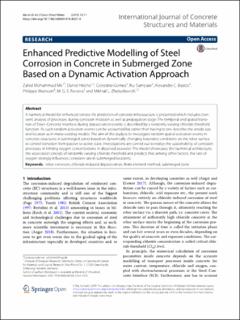| dc.contributor.author | Mir, Zahid Mohammad | |
| dc.contributor.author | Hoche, Daniel | |
| dc.contributor.author | Gomes, Celestino | |
| dc.contributor.author | Sampaio, Rui | |
| dc.contributor.author | Bastos, Alexandre C | |
| dc.contributor.author | Maincon, Philippe Emmanuel | |
| dc.contributor.author | Ferreira, M.G.S. | |
| dc.contributor.author | Zheludkevich, Mikhail L | |
| dc.date.accessioned | 2020-05-07T09:23:05Z | |
| dc.date.available | 2020-05-07T09:23:05Z | |
| dc.date.created | 2019-09-12T19:49:02Z | |
| dc.date.issued | 2019 | |
| dc.identifier.citation | International Journal of Concrete Structures and Materials. 2019, 13 (11), 1-18. | en_US |
| dc.identifier.issn | 1976-0485 | |
| dc.identifier.uri | https://hdl.handle.net/11250/2653598 | |
| dc.description.abstract | A numerical model for enhanced service life prediction of concrete infrastructure is presented which includes transient analysis of processes during corrosion initiation as well as propagation stage. The temporal and spatial transition of Steel–Concrete Interface during depassivation events is described by a randomly varying chloride threshold function. As such random activation events can be accounted for, rather than having to pre-describe the anode size and location as in many existing models. The aim of the study is to investigate random spatial activation events in concrete structures in submerged zones based on dynamically changing boundary conditions on the rebar surface to control transition from passive to active state. Investigations are carried out to realize the sustainability of corrosion processes in limiting oxygen concentrations in dissolved seawater. The model showcases the numerical architecture, the associated concept of randomly varying chloride threshold and predicts that among other factors, the rate of oxygen strongly influences corrosion rate in submerged locations. | en_US |
| dc.language.iso | eng | en_US |
| dc.publisher | Springer | en_US |
| dc.rights | Navngivelse 4.0 Internasjonal | * |
| dc.rights.uri | http://creativecommons.org/licenses/by/4.0/deed.no | * |
| dc.subject | Concrete infrastructure | en_US |
| dc.subject | Corrosion | en_US |
| dc.subject | Anodes | en_US |
| dc.title | Enhanced Predictive Modelling of Steel Corrosion in Concrete in Submerged Zone Based on a Dynamic Activation Approach | en_US |
| dc.type | Journal article | en_US |
| dc.type | Peer reviewed | en_US |
| dc.description.version | publishedVersion | en_US |
| dc.rights.holder | © The Author(s) 2019. This article is distributed under the terms of the Creative Commons Attribution 4.0 International License
(http://creativecommons.org/licenses/by/4.0/), which permits unrestricted use, distribution, and reproduction in any medium,
provided you give appropriate credit to the original author(s) and the source, provide a link to the Creative Commons license,
and indicate if changes were made. | en_US |
| dc.source.pagenumber | 1-18 | en_US |
| dc.source.volume | 13 | en_US |
| dc.source.journal | International Journal of Concrete Structures and Materials | en_US |
| dc.source.issue | 11 | en_US |
| dc.identifier.doi | 10.1186/s40069-018-0321-0 | |
| dc.identifier.cristin | 1724212 | |
| dc.relation.project | EC/H2020/685445 | en_US |
| cristin.unitcode | 7401,80,64,0 | |
| cristin.unitname | Materialer og nanoteknologi | |
| cristin.ispublished | true | |
| cristin.fulltext | original | |
| cristin.qualitycode | 1 | |

